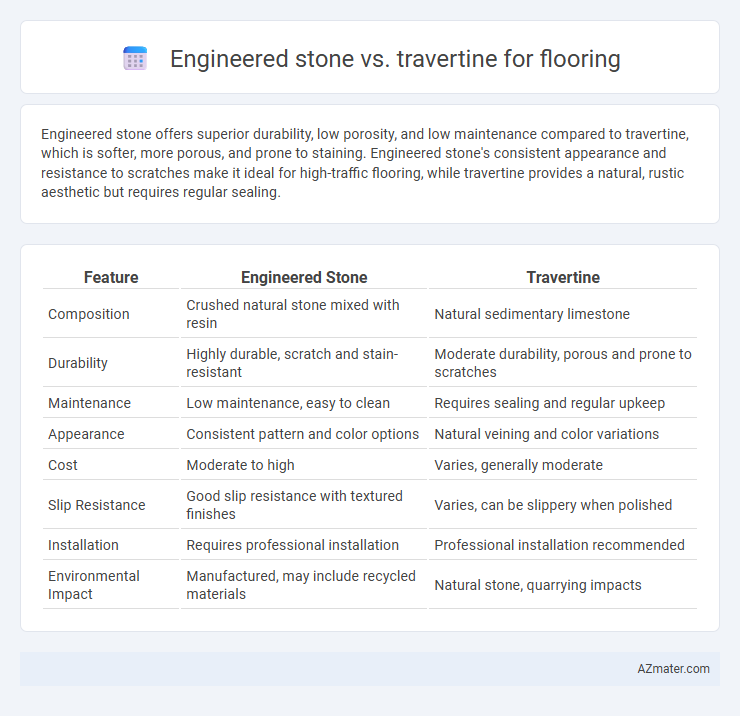Engineered stone offers superior durability, low porosity, and low maintenance compared to travertine, which is softer, more porous, and prone to staining. Engineered stone's consistent appearance and resistance to scratches make it ideal for high-traffic flooring, while travertine provides a natural, rustic aesthetic but requires regular sealing.
Table of Comparison
| Feature | Engineered Stone | Travertine |
|---|---|---|
| Composition | Crushed natural stone mixed with resin | Natural sedimentary limestone |
| Durability | Highly durable, scratch and stain-resistant | Moderate durability, porous and prone to scratches |
| Maintenance | Low maintenance, easy to clean | Requires sealing and regular upkeep |
| Appearance | Consistent pattern and color options | Natural veining and color variations |
| Cost | Moderate to high | Varies, generally moderate |
| Slip Resistance | Good slip resistance with textured finishes | Varies, can be slippery when polished |
| Installation | Requires professional installation | Professional installation recommended |
| Environmental Impact | Manufactured, may include recycled materials | Natural stone, quarrying impacts |
Overview of Engineered Stone and Travertine
Engineered stone is a composite material made from crushed natural stones like quartz mixed with resin, offering high durability, low porosity, and consistent color patterns, ideal for high-traffic flooring applications. Travertine, a natural sedimentary limestone, features unique porous textures with a variety of earth-tone colors and requires regular sealing to prevent staining and wear. Engineered stone provides enhanced resistance to scratches and stains compared to travertine, which offers authentic natural beauty but demands more maintenance.
Material Composition and Formation
Engineered stone flooring consists of crushed natural quartz mixed with resins and pigments, offering enhanced durability and uniformity compared to natural stones. Travertine is a form of limestone formed through the precipitation of calcium carbonate in mineral springs, characterized by its porous texture and natural veining. The synthetic composition of engineered stone provides greater resistance to stains and scratches, while travertine's natural formation results in unique surface patterns and requires regular sealing to maintain its integrity.
Aesthetic Appeal and Design Versatility
Engineered stone offers a highly customizable aesthetic with consistent patterns and a wide range of colors, ideal for modern and sleek flooring designs. Travertine provides a timeless, natural beauty with unique veining and warm earth tones that enhance traditional and rustic interiors. Both materials deliver distinct visual impacts, but engineered stone stands out for greater design versatility and uniformity, while travertine brings organic texture and classic elegance.
Durability and Strength Comparison
Engineered stone offers superior durability and strength compared to travertine due to its composite structure combining natural quartz and resin, making it highly resistant to scratches, stains, and impact. Travertine, a natural limestone, is more porous and softer, requiring regular sealing to protect against wear and damage, which reduces its long-term resilience as flooring. For high-traffic areas, engineered stone provides a more robust and low-maintenance solution, ensuring lasting performance and structural integrity.
Maintenance and Cleaning Requirements
Engineered stone flooring offers superior resistance to stains, scratches, and requires minimal maintenance, making it easy to clean with just mild soap and water. Travertine, a natural stone, demands regular sealing to prevent moisture absorption and staining, and specialized cleaning products to avoid surface damage. Overall, engineered stone provides a more durable and low-maintenance flooring option compared to the porous nature of travertine.
Cost Analysis and Value for Money
Engineered stone flooring typically costs between $50 and $70 per square foot, offering superior durability and low maintenance compared to Travertine, which ranges from $5 to $20 per square foot but requires regular sealing and is prone to scratches and stains. While Travertine provides a natural, classic aesthetic with variable patterns, Engineered stone delivers consistent appearance and higher resistance to wear, making it a better long-term investment for high-traffic areas. Evaluating initial costs alongside maintenance expenses and lifespan, Engineered stone offers greater value for money despite a higher upfront price.
Installation Process and Considerations
Engineered stone flooring offers a quicker installation process due to its consistent thickness and pre-finished surface, requiring minimal grout and adhesive compared to travertine. Travertine installation demands more skilled labor to handle variations in stone thickness and porousness, necessitating sealing to prevent staining and frequent maintenance. Consider substrate preparation compatibility, with engineered stone working well over radiant heating systems while travertine requires careful moisture barrier application to avoid damage.
Environmental Impact and Sustainability
Engineered stone flooring offers superior environmental benefits due to its use of recycled materials and lower water consumption during production compared to travertine, which involves quarrying that disrupts natural landscapes and generates significant waste. Travertine, a natural stone, has a higher carbon footprint from extraction and transportation processes, whereas engineered stone can be manufactured locally, reducing emissions. Choosing engineered stone supports sustainability goals by minimizing resource depletion and promoting eco-friendly practices in flooring solutions.
Slip Resistance and Safety Features
Engineered stone flooring offers superior slip resistance due to its non-porous, textured surface that enhances safety in wet or high-traffic areas. Travertine, while aesthetically appealing with natural pits and variations, requires sealing to improve slip resistance as untreated surfaces can be slippery when wet. Safety features for engineered stone include integrated anti-slip coatings, whereas travertine demands regular maintenance to maintain its grip and prevent accidents.
Best Applications for Residential and Commercial Spaces
Engineered stone offers superior durability and stain resistance, making it ideal for high-traffic commercial spaces and busy residential kitchens or bathrooms. Travertine provides a natural, classic aesthetic with moderate hardness, suited for low-traffic residential areas such as living rooms or decorative accents. Both materials require different maintenance levels, with engineered stone being low-maintenance and travertine needing periodic sealing to preserve its appearance.

Infographic: Engineered stone vs Travertine for Flooring
 azmater.com
azmater.com